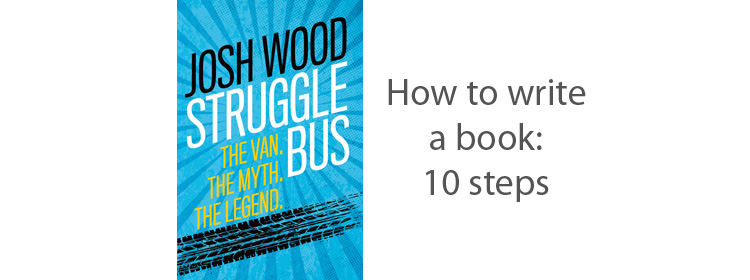As Struggle Bus has spread, I’ve received some variation of the following question repeatedly: “Can you tell me how to write and publish a book?” If you’re someone who would like an answer to that question, this post is for you! If not, well, ignore this. There are a lot of words here. A lot of words.
Before I answer the question, it’s important that I lay down two ground rules.
1) This is not my day job. There are many, many people who are far more qualified than I to answer the question. This post contains the process that worked for me personally as a rookie writer. This process was shaped by many failures. In other words, I learned much of this the hard way.
2) Once you enter the publishing phase of the author adventure, opinions vary widely and passionately regarding the different options available. So, take my opinion with a grain of salt. See ground rule 1.
That said, let’s get started. Here are my 10 steps to write and publish a book.
Step one: write!
“Gee whiz, Josh. This guide of yours is off to an amazing start. Thanks for nothing.”
Here’s the deal. Of course, “write!” should go without saying; but I can assure you this: it does not go without saying. It didn’t for me. It doesn’t for many writers. Perhaps I can explain better in the form of a parable about a man named Gary.
Gary was scrolling Instagram one day when he came across a before and after photo of an older, muscled-up fellow. The photo had the following caption: “tap the link in my profile to find out how I went from flab at forty to fab at fifty! #beastmode #blessed”
“Don’t mind if I do!” thinks Gary.
Gary taps the link and enters a world of workout plans, vegan recipes, and dietary supplements. Gary—who is pushing 40-years-old and struggles for breath when walking up a flight of stairs—has an adrenaline-shooting moment of inspiration.
“If this guy could do it, why can’t I?!” Gary excitedly says out loud to no one in particular.
Gary is resolved. He decides to seize the day, change his life, and get in shape.
What does Gary do? Does he go for a jog or start exercising? Heck no. Gary begins by reading a book on nutrition. Then, Gary binge-watches a bunch of fitness YouTube videos. After that, he spends a few hours creating nutrition plans and workout schedules. The following day, Gary drives over to the nearest sporting goods store and buys $1,000 worth of workout clothes. The day after that, he sees an ad for a Peloton bike pop up on Instagram feed. He spends the next two days talking himself into and out of purchasing the bike. Ultimately, Gary decides that he’s worth it. He buys the bike. Then, Gary spends countless hours researching all things Peloton, buying a ton of accessories, and setting up an Instagram-worthy Peloton zone in his garage. #PELOTONZONE #LETSGO #BEASTMODE. He contemplates getting a Peloton tattoo but talks himself out of it. After the research is done, plans are made, accessories are purchased, and workout zone is perfectly set up, Gary resolves to begin his life/body transformation the following day.
Day one of Gary’s workout plan arrives. He excitedly dresses up in $300 worth of athletic gear and snaps 27 “before” photos and spends a full 15 minutes crafting the perfect caption. Ultimately, he deletes the caption and replaces it with a simple #DAYONE #LETSGO. Then, ol’ Gary hops on his shiny new Peloton and gets to work.
10 minutes later….
AHHHH! LEG CRAMPS! PAIN!
Gary quits. His Peleton becomes a dusty clothes hanger, never to be ridden again. Gary’s health is no better off than when he first felt that jolt of inspiration. The end.
Here’s the deal: it’s really easy to become the Gary of writing a book. If you really want to write a book though, you can’t be like Gary. You have to start by sitting down and writing. You have to get to work. Don’t worry about researching publishers. Don’t worry about researching the best ways to unlock your chi. Don’t worry about researching the best ways to market your book. Don’t worry about researching book design options. Don’t worry about creating the perfect writing space or purchasing all the perfect writing accessories. Just sit down and start writing. That’s it. That’s step one. Here’s a tip if you’re not sure where to start: start by writing out all the of stories you want to tell. Stories trump data, and storytelling trumps pretty much everything else in writing. So, crafting your stories is a great place to begin.
Step 2: Social media.
I hate that this is a step, but there’s no way around it. If you’re an aspiring author in 2020, you must embrace social media. Try to get into the habit of posting something once per day. Do your best to begin the painful work of building an audience. Worth noting, if you have dreams of a major publishing company reading your book, loving your book, and promoting your book for you in a way that allows you to avoid social media altogether, allow me to smash your dreams.
Do you know what publishers want as much as great books these days? They want a pre-existing following on social media. I don’t know if it’s true, but I heard somewhere that many publishing companies won’t even look at you unless you have at least 50,000 followers. Tip: grab a copy of Platform by Michael Hyatt. If you are unfamiliar with Michael Hyatt, he’s the former CEO of Thomas Nelson Publishing Company. He knows a thing or two about what publishing companies are looking for.
Step 3: Finish a rough draft of your book in its entirety.
Yes, do this before worrying about publishing options, color scheme, marketing plan, or overall book design. You’ll still have plenty of time for those things. If you do this right, you’re not even close to finished at this point. In fact, if my experience is any indication, you have at least seventeen “Forget it! I quit! I’m terrible at this! Light it all on fire!” episodes ahead of you before you finish this project. Josh’s 10-Step Plan to Write a Book is super encouraging so far, no?
So, finish your rough draft. This includes arranging and naming your chapters.
Step 4: Target audience.
Now that your rough draft is finished, spend a good chunk of time honing in on your target audience. In this step, you want to make your best educated guess as to which demographic will get the most out of your book. Be as specific as possible. For example, the target audience for Struggle Bus was as follows: adoptive middle-class parents in the mid-western United States who have at least two children and are in their early thirties to late forties.
“Hey Josh, I’ve seen some of your annoying ads on Facebook. You are clearly marketing to people who don’t fit into that demographic. So, why bother being so specific?”
Thanks for asking. We’re not honing in on a target market for marketing purposes right now. We’re doing it for the sole purpose of soliciting feedback from the right people. On to step 5…
Step 5: Friendly fire.
Find 3-10 people in your exact target demographic to review the rough draft of your book for you. Then, give them specific guidelines for giving you feedback on your book. For example, don’t say, “Tell me what you think!”
Say, “I really value your opinion. Here’s what I am and am not looking for specifically. First, I am not looking for grammatical, spelling, syntax, or technical issues unless there are huge, glaring problems. I’ll work on that stuff later. Right now, I am wanting feedback on:
- The book as a whole. Do you think the main point is good enough to justify the book?
- Does it make logical sense, and is it easy to follow? Specifically, where was it hard to follow? What stories, thoughts, or sections of the book didn’t make sense to you?
- How do you feel about the length? Too long? Too short? About right?
- Are there any glaring issues? In your opinion, what are the biggest problems with the book?
- Is there anything (a story, chapter, paragraph, etc.) would you change or delete? Is there anything you would add?
One important note when asking for feedback: only ask for feedback from people you trust. You need to trust them at least enough to make changes based on their feedback. In other words, only ask for feedback if you’re willing to change your beloved project based on the feedback you receive. If you aren’t willing to change, then you’re not really asking for feedback. You’re asking for a pat on the back. A pat on the back is really nice, but ultimately not as useful as a kindly-worded slap in your literary face.
Step 6: Review all of the feedback given to you, and search for a consensus.
Compile all of the feedback you receive. Get clarification if needed. Search for common themes. Then, brainstorm ways to improve your book based on the feedback you received. I found this tip from Neil Gaiman to be useful here: “Remember: when people tell you something’s wrong or doesn’t work for them, they are almost always right. When they tell you exactly what they think is wrong and how to fix it, they are almost always wrong.”
Step 7: Rewrite your entire book.
Step 7 sounds awful, because it is. Here are a couple key points to remember as you rewrite your book:
- While you want to do your best to incorporate the consensus ideas that you received during the feedback step, don’t forget to keep your voice throughout. Don’t forget that, at the end of the day, you know more about how you want your book to sound than your feedback-givers. Don’t lose your voice.
- Spend most of your time on the stories that your feedback-givers said were hard to follow. You want to make sure that you get the stories right. They are the meat of any book worth reading.
Step 8: Treat Yo Self.
Congratulations! You just survived one of the most painful steps of the book-writing process. Reward yourself with some ice cream or some writing accessories or coffee or one of those Peloton bikes or something.
Step 9: Technical editing.
Hire an editor. Worth noting: I found editing to be more art than science. Take all suggested edits with a grain of salt. Sometimes, it’s ok to bend the rules. Sometimes, it’s not. Ultimately, it’s your book. You should decide on the terms, not the editor.
Note: this is round one of editing. If you are self-publishing, you will want to go through several more rounds of editing. If you go with another publishing method, your book will undergo more rounds of editing once it reaches that phase of the process. So, why go through the pain and/or cost of editing now if a publisher is going to do it for you later? Here’s why: you want your book to look as polished as possible before submitting it to a publisher, because you want to give it the best chance of succeeding.
Step 10: Research and choose a publishing option.
We’re finally ready to talk about publishing options. Many, many articles have been written on this subject; so, I won’t belabor the issue here. There are pros and cons to every approach. Fair warning: you’ll probably be vilified by people no matter which option you choose. Ignore the haters. Go with what works best for you and finish your book. Which option is best for you? It depends. Personally, I landed at a company called Lucid Books. Here’s why.
I didn’t have the time, energy, or talent to do what it takes to land my book at a major publisher (here’s a good blog post on getting published with a major publisher: https://www.thebalancecareers.com/how-to-get-published-by-a-major-publisher-2799836). As importantly, I hadn’t put the time into building a social media following. Also, I’m a rookie. So, as much as I loved the idea of working with a traditional publisher, I estimated that the odds were very much against me.
I wasn’t cut out for a major publisher; but I decided that I wasn’t cut out for self-publishing either. I’m terrible at design. I’m terrible at marketing. I’m terrible at self-promotion. I hate it. So, if I wanted any chance at a good book design or marketing plan, I knew I needed someone else involved in the process. Fortunately, I have an author friend (an actual author, not a wannabe like me) who directed me to a small publisher, Lucid Books. Worth noting: although I didn’t feel self-publishing was the best option for me, it may be a wonderful option for you. In fact, it is easier than ever to self-publish with Amazon; and, it is a great option for many aspiring authors. Here’s how it works: https://kdp.amazon.com/
Ultimately, I landed at a small publisher. Their process is a hybrid approach between self-publishing and landing a deal with one of the publishing behemoths. Here’s more about Lucid Books: https://lucidbookspublishing.com/about/. They’ve been a great fit more me.
There you have it. While many stages of the process were agonizing for me, I encourage anyone to write a book. It is worth the pain. I feel incredibly fortunate and lucky that Struggle Bus is rolling along as well as it is. But, even if it wasn’t (and even if the momentum soon slows), I feel great about having completed the project. At the end of the day, I have a collection of stories to look back on later on in life with much joy. To me, that alone is worth it. I think it will be worth it to you, too. Good luck!
Oh, and if you have specific questions, I’ll be happy to give my unqualified opinion and pretend I know what I’m talking about. Contact me.




No Comment